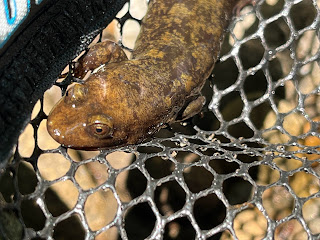Field Notes 8 Aug 2023: Infinite populations of varying density
Some time ago, Fisheries Biologist Matt Kulp (of the Great Smoky Mountains National Park) mentioned to me that they often turn up Desmognathus salamanders when electroshocking for Brook Trout. “Huh,” I said. “Maybe if someone wanted to finally do serious population genetics with those critters, that would be the way to get good samples.” Well, now I have a student (Rebecca Chastain) who wants to do serious population genetics with those critters, and we’ve been partnering with the fish crew this summer to get good samples.
The fish crew uses a three-pass depletion protocol to estimate trout densities. Basically, you catch as many fish as you can, set them aside in a holding pen, then do it again. The number of fish caught on the second and third passes should be less than on the first pass, and you can use the changes in those numbers to estimate the total number of fish in the survey area. The fundamental assumption is that each time you go through the survey area, you have the same capture rate as the time before.
Now, our main interest with the salamanders is to get a little tissue for DNA analysis, but wouldn’t it be neat to also estimate their densities with the three-pass protocol? Salamander enthusiasts often boast that they are the most numerous vertebrate in southern Appalachian forests, but few studies have successfully estimated population densities.
My first time out with the fish crew we caught 24 salamanders on the first pass (and fewer than 20 Brook Trout!), and 13 on the second pass. Had we stopped then, we would have estimated that there were 52 (+/- 15) salamanders in the 100-meter survey area. But we got 25 on the third pass (impossible if the two-pass estimate was correct). If this was not just a statistical fluke, we are left with three possibilities: (1) The population is actually so large that removing 37 individuals is effectively no change, (2) a bunch of salamanders decided to “trespass” and climbed over the barriers to enter the site in the 30 minutes or so that had elapsed since the previous pass, or (3) something about the disturbance of eight people stomping though the creek with shockers and nets made the salamanders more “catchable” on the third pass. I consider the latter the most likely by far. But that doesn’t change the fact that we cannot compute a credible estimate from the data.
We have repeated the experiment six additional times now and the patterns has held. Though the absolute numbers are different at different sites, the third pass has always yielded more salamanders than the second pass. So, we joke that the populations are all infinite, even though densities are clearly lower in some places than others.



Comments
Post a Comment